In the last three parts, we looked at the implementation plan for supply, training, deployment, and operation of the agenda of ‘expansion of medical personnel.’
As pointed out earlier, even if the supply and demand estimation organization estimates the number of doctors through scientific statistics and data analysis, if there is a separate organization capable of political intervention at the final decision-making stage, such a system cannot be persuasive at all. .
In this fourth part, we will look at how the government will reorganize the increased number of doctors and change medical supply. Here, a reform of the provider-centered medical system is proposed that will bring about changes in the roles of each type of medical institution along with reform of the payment system.
2. Innovative medical supply, utilization system, and reconstruction of local medical care
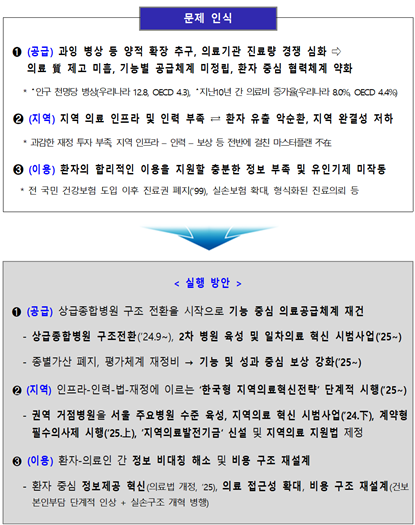
1) Supply
The contradiction between the large supply of hospital beds compared to OECD and the number of doctors per 1,000 people is presented as a recognition of the problem without any consideration. In the end, the problem was recognized as competition to increase the amount of treatment by supplying more hospital beds. However, in the current medical law system, which officially prohibits the inducement of patients, it is difficult to intentionally increase treatment costs without patients’ voluntary use of medical treatment.
In the end, the demand side of medical users rather than the problems of medical providers should be seen as the greater cause of the increase in medical costs, but this aspect is not being considered at all. In other words, the government is never considering controlling medical consumers when it comes to medical issues.
2) Region
Ironically, although the problem is recognized that there is an oversupply of hospital beds, the infrastructure for local medical care is said to be insufficient. It is said that patients are leaking out because of this. This problem is occurring not only in medicine but also in society as a whole, and is a problem caused by population decline in almost all regions except the metropolitan area.
Medical care is a labor-intensive industry, and especially higher-level medical institutions require a larger background population and medical personnel, but it is difficult to maintain that number in rural areas. Ultimately, a lack of population leads to a lack of profitability, which leads to difficulties in maintaining infrastructure.
In addition, as the outflow of patients from rural areas to the metropolitan area has intensified since the spread of KTX, the problem has become impossible to resolve through the efforts of medical providers alone, as mentioned earlier.
Nevertheless, the special committee proposed a plan to maintain only the medical supply infrastructure by tying medical providers to local regions through law and finances. We will check whether medical care in Korea, which relies more than 90% on private medical care, can be maintained.
3) Use
Patients, who are users of medical services, are always good victims, and they recognize that the problem is that even though medical supplies are available, they are unable to use them rationally because they do not receive proper information, and that medical providers do not properly operate the medical delivery system.
As an implementation plan to improve this area, a plan was proposed to resolve information asymmetry in a patient-centered manner and redesign the cost structure, but it seems that the recognition of the problem and the solution method do not match. Let’s find out what direction was set through specific implementation plans.
[1] Reconstruction of the medical supply system centered on function
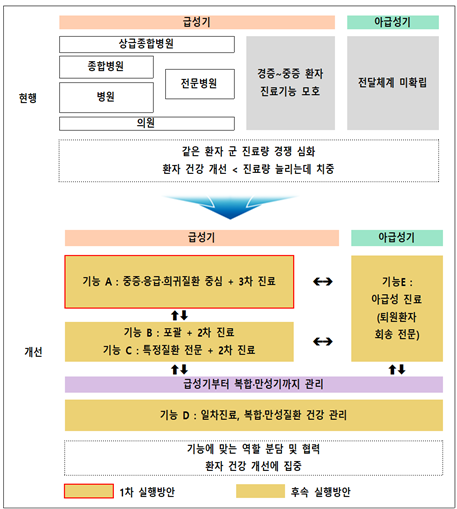
It diagrams the roadmap for rebuilding the medical supply system. The main feature can be divided into two. One is that various current medical institutions will be classified according to their functions, and the other is that new subacute care medical institutions that did not exist before will be established.
Currently, only the first implementation plan has been announced, so it appears that only the implementation plan for function A, i.e., tertiary general hospitals, has been specifically prepared. However, considering the definitions of concepts and words in the current chart, the barriers to each medical institution through the ‘payment system’ are clearly defined. It is predicted that there is a plan to build it.
In other words, if the already announced value-based payment system is used to apply differential compensation for medical expenses according to diagnosis, the patient group that each medical institution will be responsible for will be established. Once this patient group is formed, the functions of each medical institution will naturally be fixed.
Ultimately, as pointed out earlier, in order to adjust these aspects in a state where the health authorities have no will to restrict or control medical consumers, they have no choice but to forcibly coordinate medical providers, and that powerful control is the payment system. This is a tyrannical method against medical providers that has continued under the single public insurance mandatory designation system since the launch of the health insurance system.
1. Redesign of the medical institution supply system based on function
1) Structural transformation of tertiary general hospitals – 1st implementation plan
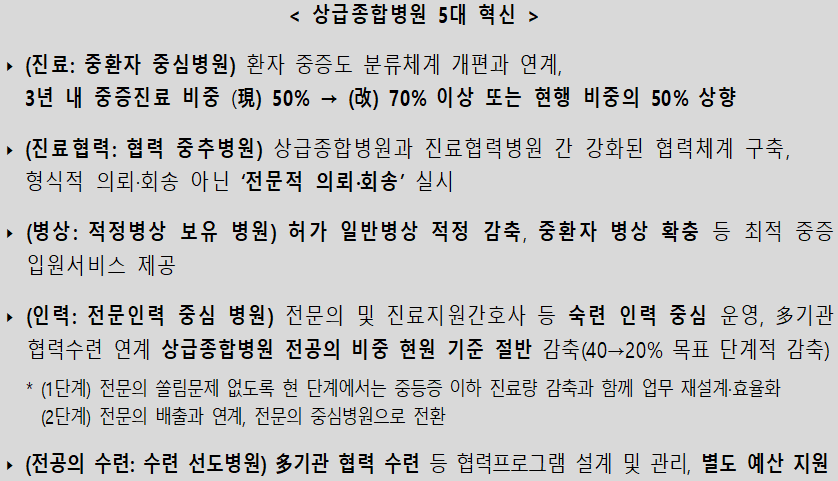
As part of the ‘specialist-centered hospital’ proposed in the essential medical package policy, the most important goal is to reduce dependence on medical residents. The goal is to gradually reduce the proportion of medical residents from the current 40% to 20%.
The problem is that since the number of medical school students has already been increased, it is necessary to secure a sufficient number of professors to educate these students, so it is necessary to hire specialists, but in order to maintain employment, more residents must be trained and turned into specialists. Considering this supply and demand, it is doubtful whether it will be possible to reduce the proportion of medical residents in teaching hospitals from 40% to 20%.
However, it may be possible if we consider the essential medical package policy that prevents the outflow of specialists from clinics, which are primary medical institutions, and encourages employment at hospital level or higher. Of course, it is expected that the labor costs of specialists will fall accordingly.
Currently, tertiary general hospitals in the metropolitan area are carrying out remodeling work to reduce multi-bed rooms to 2-, 3-, and 4-bed rooms, taking advantage of the current gap in specialties and low bed utilization. We are working hard to achieve the 10% reduction requested by the government.
In addition, with the passage of the Nursing Act, each hospital-level medical institution was able to use nurses as medical assistants through the professional nurse system, greatly reducing dependence on medical residents.
Accordingly, these general hospitals are making ceaseless preparations before the implementation of the Nursing Act next year, including redesigning the division of duties for medical support nurses using professional nurses and establishing education and training plans.
In particular, the active cooperation of these tertiary general hospitals is reflected in the expectation of a payment system that strengthens compensation for essential medical care, especially severe diseases, actively proposed in the essential medical package policy, and the compensation standards (draft) for this are as follows.
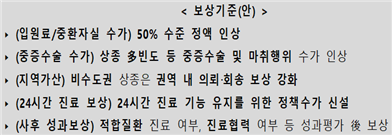
It is expected that the treatment volume that tertiary general hospitals have maintained by increasing the treatment volume by covering mild diseases, moderate diseases, and follow-up observations, and the compensation received by switching to focusing on severe diseases, will be similar, with no significant difference.
If such a group of patients with severe diseases centered on these functions is formed in a medical institution, the scope of training and education for residents will inevitably be narrowed. The solution to this problem is ‘multi-institutional cooperative training’, which means dispatching workers to other medical institutions. The mandatory medical package policy does not appear to be helpful in improving the quality of resident education.
2) Secondary hospital development – follow-up review
The goal is to transform secondary medical institutions into general hospitals and hospital-level medical institutions. Although it is not included in this announcement, considering the regional complete medical system and regional responsible medical institution standards that will be explained later, the current general hospital standard of 100 or more beds + 7 or more medical departments is expected to be strengthened even further. (e.g., more than 250 beds + more than 7 medical departments + 24-hour emergency room + intensive care unit with more than 10 beds, etc.)
And the current hospital-level medical institutions that do not meet these requirements are expected to be converted to specialty hospitals or to the newly proposed subacute medical institutions.
In the end, the reason for classifying hospital-level medical institutions in this way is ostensibly a function, but general hospitals are grouped under the DRG (comprehensive fee system) to limit the increase in testing volume, and by nurturing specialized hospitals, it reduces the length of stay instead of increasing the bed turnover rate. It is done.
3) Primary care innovation – follow-up review
The essence of the essential medical package policy is the restriction of the supply of specialized medical services to clinic-level medical institutions. As Vice Minister Park Min-soo stated, the view of the Ministry of Health and Welfare is that the supply of specialized medical care at clinic-level medical institutions is excessive and that it is bad medical care that produces unnecessary medical care that is not covered by insurance.
Therefore, through medical reform, clinic-level medical institutions are literally required to perform only primary care functions and only provide outpatient treatment such as integrated health management (chronic diseases, geriatric diseases, etc.).
It appears that an implementation plan will be prepared and presented in which tests, techniques, and procedures will be performed at hospital-level medical institutions, while clinic-level medical institutions will only perform examinations and health care consultations, and further strengthen compensation accordingly.
4) Establishment of subacute system
As mentioned earlier, medical institutions that are not recognized as general hospitals in existing hospital-level medical institutions will be forced to convert to subacute medical institutions.
Although the definition or function of this medical institution has not yet been established, it is expected that it will be a medical institution that will play that role in cases where a diagnosis has already been made and tests are no longer needed, but hospitalization is required, or hospitalization for rehabilitation at a medical institution is necessary. It is predicted.
This is the only area where the next generation can take on the challenge of policies related to the essential medical package and medical reform.
2. Reorganizing the function- and performance-oriented supply base
1) Reorganization of severity classification system
As mentioned earlier in the roadmap explanation above, the classification system must be established in order to establish each function and collect patients with severe diseases to compensate for the fees paid to tertiary general hospitals.
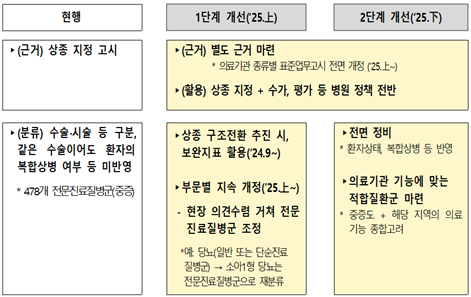
2) Improvement of business system
Nothing changes, just the name changes. The name change will be promoted through a contest, and in order to change the name, the Medical Service Act must be revised. When revising the Medical Service Act, it will be necessary to take a close look at the additional revised laws. It would not be an attempt to revise the medical law simply to change the name.
Of course, we are also pursuing a reorganization that strengthens the criteria for designating tertiary general hospitals in order to focus on functions for severe diseases, but the question of whether such medical supply will be possible if the new normal is achieved does not disappear.
For doctors who leave essential medical care and serious diseases, the biggest problem is not compensation, but civil and criminal lawsuits, that is, legal risk. Unless this is resolved, those who will enter this field will not be able to solve it no matter how much time passes and the number of medical schools increases. Because it won’t work.
In that case, we need to maintain or increase the current medical capacity for serious diseases while preventing the departure of only the personnel currently engaged, but how many medical institutions will be able to meet the criteria for designation as tertiary general hospitals if they are strengthened? I think there will come a time when the government, not the medical community, will be the one to worry about this.
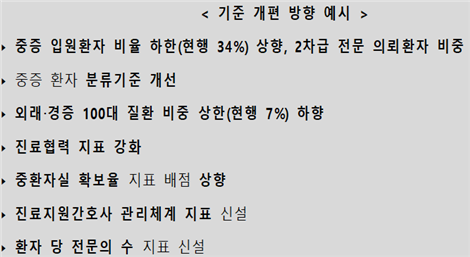
3) Improvement of evaluation and compensation
Abolish the type-specific addition and introduce a function-performance compensation system at the institutional level. If you look at the roadmap, the type-specific addition will disappear as the clinic, hospital, and tertiary general hospital systems have been erased, and the function-performance compensation system is a transition to a value-based payment system as announced in the payment system reform. In other words, different additional rates are applied depending on the indicators for each medical institution and differential compensation is made according to the HIRA’s evaluation standards.
It may be a reasonable compensation system from the insurer’s perspective, but from the medical provider’s perspective, it must accept the irrationality of receiving different compensation for the same medical supply, and it is a dominated compensation system in which a relationship between A and B is formed where it is difficult to refuse unreasonable other demands from the insurer. am.
All of these unfair practices have been accepted by high-level general hospitals, but the Korean Medical Association, which had a negotiating position on behalf of the lawmakers, did not offer much resistance.
However, in the end, these are not limited to tertiary general hospitals, but have been applied to all hospital-level secondary medical institutions and even clinic-level medical institutions, which are primary medical institutions. It is expected that such a reform of the payment system will be announced in the second and third implementation plans of the Special Committee on Reform.
